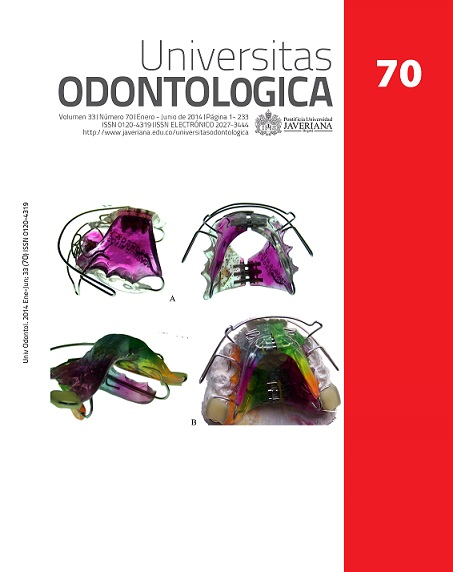Abstract
Background: The first permanent molar (FPM) erupts at the age of six in average (5-7 years of age). This tooth does not have a temporary predecessor and is one of the most affected by tooth decay. It is commonly restored even before the full eruption of its occlusal surface in the oral cavity. The FPM is also often lost, which is associated with the development of maxillofacial disorders at early ages. Purpose: To determine the caries prevalence of the FPM among patients who attended the dental clinics at the Universidad Cooperativa de Colombia, campus Villavicencio, between 2006 and 2011. Methods: This was a descriptive observational study that had as universe 3.394 records of 5-to-60-year-old patients seen at the Universidad Cooperativa de Colombia, campus Villavicencio. Results: The sample consisted of 800 fully developed records (492 females and 308 males). Caries prevalence of the FPM was 46%, DFMT index = 3.36. The most FPM affected surfaces were upper occlusal and lower occlusal-vestibular. The DFMT index by age group was: 5-14 years = 2.18; 15-44 years = 3.81; 45-60 years = 3.87. Conclusion: Findings of this study show the need of creating health promotion, preventive, interceptive, and restorative programs against dental cavities of the FPM, with a special emphasis on health promotion and preventive measures.
KEYWORDS
dental caries; first permanent molar; prevalence; DMFT Index
This journal is registered under a Creative Commons Attribution 4.0 International Public License. Thus, this work may be reproduced, distributed, and publicly shared in digital format, as long as the names of the authors and Pontificia Universidad Javeriana are acknowledged. Others are allowed to quote, adapt, transform, auto-archive, republish, and create based on this material, for any purpose (even commercial ones), provided the authorship is duly acknowledged, a link to the original work is provided, and it is specified if changes have been made. Pontificia Universidad Javeriana does not hold the rights of published works and the authors are solely responsible for the contents of their works; they keep the moral, intellectual, privacy, and publicity rights.
Approving the intervention of the work (review, copy-editing, translation, layout) and the following outreach, are granted through an use license and not through an assignment of rights. This means the journal and Pontificia Universidad Javeriana cannot be held responsible for any ethical malpractice by the authors. As a consequence of the protection granted by the use license, the journal is not required to publish recantations or modify information already published, unless the errata stems from the editorial management process. Publishing contents in this journal does not generate royalties for contributors.


